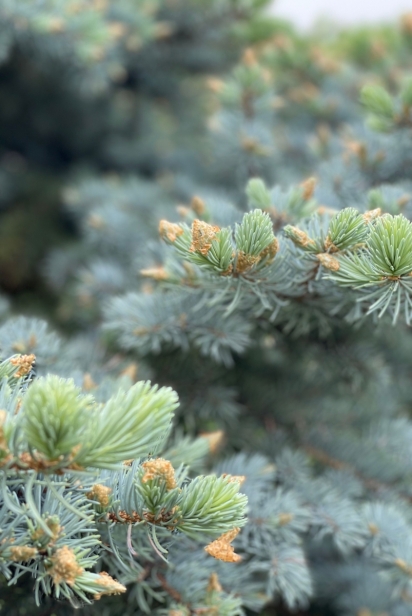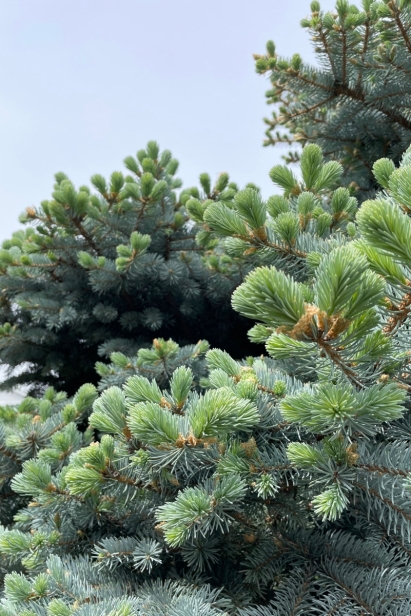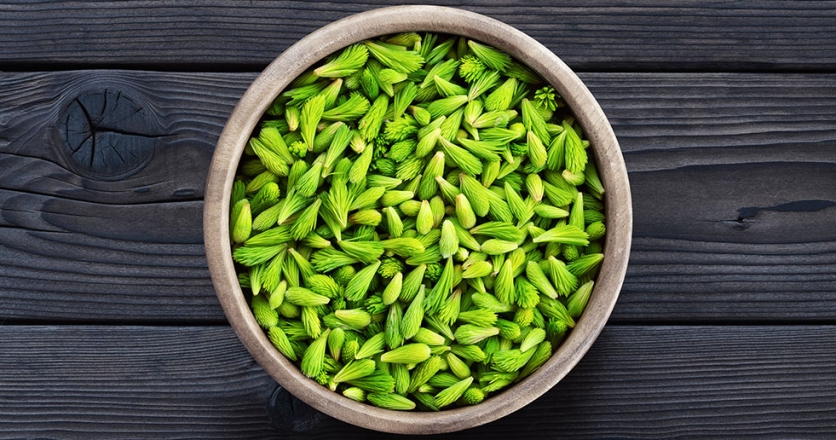Front-Yard Foraging: Spruce Tips
I’m looking forward to spring. Not because I’m tired of winter, but as we move past the sap-flowing, half-snow, half-mud stretch, the trees in my yard start to come back to life and the air seems a little sweeter. All sorts of the year’s first delicacies begin making their fleeting appearances.
When this new growing season starts, market stalls, foragers and restaurants begin to offer and process many of these time-limited gems — fiddleheads, morels, ramps, hosta sprouts, various blossoms and spruce tips. The new growth from spruce trees may be one of the easiest to forage. Heck, I don’t even have to leave my front step to pull shoots off the funny decapitated blue spruce that blocks the view of my front door.
Spruce trees are coniferous, cone-bearing trees, related to firs, redwoods, junipers and pines. Each of the spruce tree's short needles attach directly to the stem in contrast to pine needles, for example, which hang out in groups. While many conifer tips are edible, make sure to positively identify the tree species first as many types of yew are toxic to humans and hemlocks tend to look like yews.
In early spring, the tips emerge from the following year’s growth, bright green in colour (or blue-green in the case of the blue spruce), soft, feathery and often still wearing their papery husk hats. To harvest the tip, pinch it where it is connected to the stem and pull it off. Super easy.
For the health and aesthetic of the tree, don’t harvest all the tips in one area (or it will grow lopsided) or around its top (you’ll stunt it). Many people use spruces as ornamental landscaping (it’s probably best not to harvest half of your neighbour’s tree), plus as it is with all urban trees, you want to avoid harvesting from trees that are close to areas of pollution. The window for tender sprouts is relatively short — a week to 10 days — before they start to harden into needles.
Now that you have them, what will you do with them? Spruce tips are popping up in beer, sodas, ice cream and condiments. Each type of spruce tree has a unique flavour profile, but they generally taste citrusy with a hint of rosemary. Spruce tips can be eaten raw or blended in dishes in which you would like to increase the acidity and brightness, such as sauces or marinades for chicken, pork, tofu or white beans. You can use spruce tips in tea or a tincture, steep them in vinegar or syrup or blend them in salt or seasoning mixes. Aside from adding a surprising flavour boost, these tips are high in vitamins A and C and contain magnesium, phosphorous and chlorophyll.
Spruce tips are generally clean, but you can remove their party hats and give them a quick rinse to remove any dust and debris. They will last a few months in a paper bag in the fridge, if you can’t use what you just harvested. They also freeze well, if you want to keep them even longer.
Spruce tip mayo
Makes about 2 cups
2 egg yolks
1 teaspoon apple cider vinegar
1 teaspoon Dijon mustard
1/2up spruce tips, chopped
2 cups neutral flavoured oil
Pinch of salt and pepper
In a mixing bowl, add the egg yolks, vinegar and a pinch of salt and pepper. Using a whisk, mix well. Slowly add the oil, starting with a few drops at a time, whisking constantly until all of the oil is incorporated. Mix in the spruce tips.
The mayo can be kept refrigerated for up to a week. Spruce tip mayo is a great addition to sandwiches, tuna or potato salad, devilled eggs, as a dip for spring vegetables or as a replacement for tartar sauce for fish 'n' chips.
Spruce tip shortbread cookies
1 cup butter, unsalted, room temperature
1/2 cup sugar
2 cups all-purpose or gluten-free flour
1/3 cup spruce tips, minced
Pinch of Kosher salt
Add the butter to a stand mixer with a paddle attachment and cream the butter on a medium-low speed. Add the sugar and salt and blend for another minute. Add the spruce tips and blend for another minute.
Add the flour to the mixer, one cup at a time, mixing until combined (20 to 30 seconds) each time.
Lightly flour your work surface and turn the dough out onto it. Push the dough together to a ball. Add the ball into a chilled ceramic bowl, cover with a towel and place into the refrigerator until the dough is chilled through.
Preheat oven to 325 F.
Remove the dough from the fridge and place it onto a clean work surface with a touch of flour, or onto a piece of parchment. Using a rolling pin, push and roll the dough, giving it an occasional quarter turn, until the dough is rolled out to approximately one 1/4-inch. Cut cookies into any shape you desire.
Place cookies onto lines baking sheets and bake for 10 to 15 minutes (based on the size of cookie you cut) or until lightly browned. Remove from the oven and allow them cool for five minutes before serving.
Spruce tip syrup
Makes 4 cups
4 cups water
4 cups sugar, we used raw
4 cups spruce or fir tip , cleaned
Add all ingredients into a clean pot and bring to the boil. Turn the heat off and let the pot sit until the syrup has reached room temperature.
Cook the syrup longer to reduce it, if you want a thicker finished product. Strain the syrup through a fin -mesh strainer into a clean jar. Keep the syrup refrigerated. It will last for a few months. Enjoy it in cocktails, teas, ice cream, pancakes and other desserts.
Looking for spruce tips in the "off-season"?
If you hit the end of the season and haven't had your fill of spruce tips, fear not; you can grow your own.
You can take a four- to six-inch cutting from a healthy tree, strip the bottom inch of needles and sit the stem in a cup of water. The cutting may take several weeks to produce fresh tips, but you can enjoy the lemony fresh bite any time of the year.







